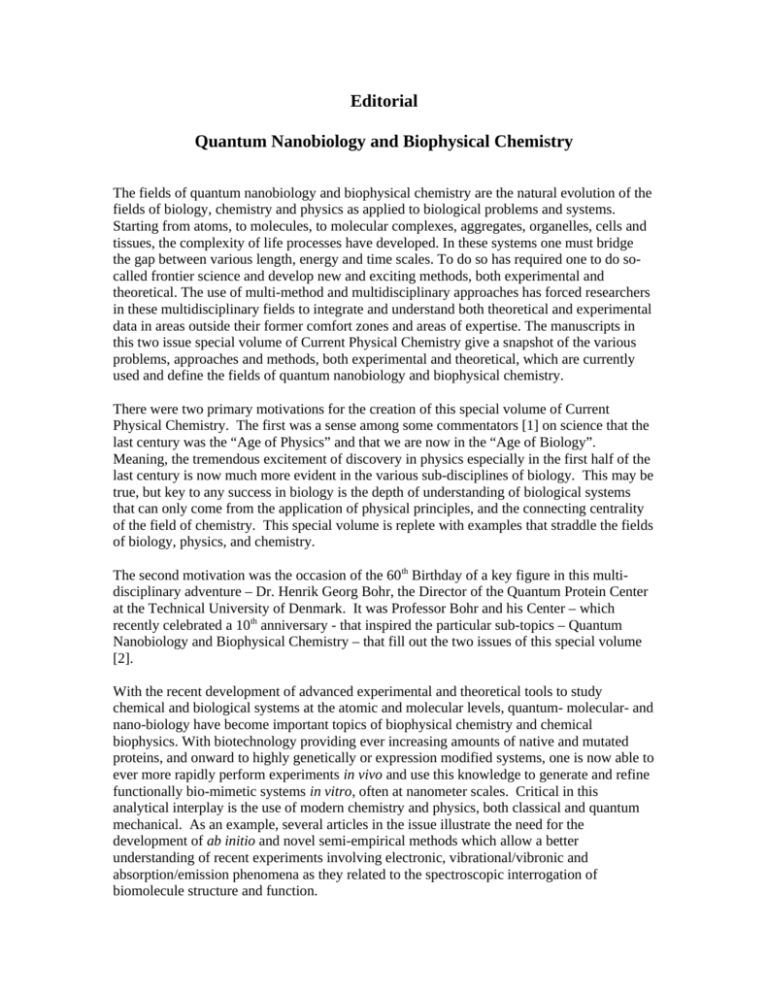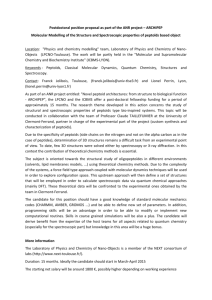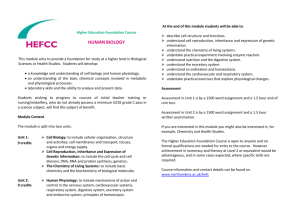Quantum Nanobiology and Biophysical Chemistry special issues of
advertisement

Editorial Quantum Nanobiology and Biophysical Chemistry The fields of quantum nanobiology and biophysical chemistry are the natural evolution of the fields of biology, chemistry and physics as applied to biological problems and systems. Starting from atoms, to molecules, to molecular complexes, aggregates, organelles, cells and tissues, the complexity of life processes have developed. In these systems one must bridge the gap between various length, energy and time scales. To do so has required one to do socalled frontier science and develop new and exciting methods, both experimental and theoretical. The use of multi-method and multidisciplinary approaches has forced researchers in these multidisciplinary fields to integrate and understand both theoretical and experimental data in areas outside their former comfort zones and areas of expertise. The manuscripts in this two issue special volume of Current Physical Chemistry give a snapshot of the various problems, approaches and methods, both experimental and theoretical, which are currently used and define the fields of quantum nanobiology and biophysical chemistry. There were two primary motivations for the creation of this special volume of Current Physical Chemistry. The first was a sense among some commentators [1] on science that the last century was the “Age of Physics” and that we are now in the “Age of Biology”. Meaning, the tremendous excitement of discovery in physics especially in the first half of the last century is now much more evident in the various sub-disciplines of biology. This may be true, but key to any success in biology is the depth of understanding of biological systems that can only come from the application of physical principles, and the connecting centrality of the field of chemistry. This special volume is replete with examples that straddle the fields of biology, physics, and chemistry. The second motivation was the occasion of the 60 th Birthday of a key figure in this multidisciplinary adventure – Dr. Henrik Georg Bohr, the Director of the Quantum Protein Center at the Technical University of Denmark. It was Professor Bohr and his Center – which recently celebrated a 10th anniversary - that inspired the particular sub-topics – Quantum Nanobiology and Biophysical Chemistry – that fill out the two issues of this special volume [2]. With the recent development of advanced experimental and theoretical tools to study chemical and biological systems at the atomic and molecular levels, quantum- molecular- and nano-biology have become important topics of biophysical chemistry and chemical biophysics. With biotechnology providing ever increasing amounts of native and mutated proteins, and onward to highly genetically or expression modified systems, one is now able to ever more rapidly perform experiments in vivo and use this knowledge to generate and refine functionally bio-mimetic systems in vitro, often at nanometer scales. Critical in this analytical interplay is the use of modern chemistry and physics, both classical and quantum mechanical. As an example, several articles in the issue illustrate the need for the development of ab initio and novel semi-empirical methods which allow a better understanding of recent experiments involving electronic, vibrational/vibronic and absorption/emission phenomena as they related to the spectroscopic interrogation of biomolecule structure and function. A general theme of the issue is on recent advances in both experimental and theoretical quantum nanobiology/ biophysical chemistry and on the marriage between theory and experiment, as well as the marriage between the multi-method approaches and multidisciplinary approaches in the spirit advocated by Zaccai, Zaccai, and Serdyuk [3]. The Guest Editors offer best personal wishes to Professor H.G. Bohr, thank all the contributors and referees who have helped create a series of papers worthy of the lofty subject matter, and earnestly hope the work may inspire a continued re-joining of what have at times become perhaps somewhat myopic approaches as science went from a philosophia naturalis to today’s focus on sub-disciplines (and further, the bifurcation of ‘applied’ and ‘basic’ research), especially in the education of young scientists. THE CONTENTS For issue 1 of the two part volume, we naturally start with a review by Professor Bohr, which in part is concerned with problems and perspectives of Molecular Biophysics of today and especially with respect to quantum aspects. Zaccai gives discussion of the ecology of protein dynamics – especially focusing on the time scale elements often missed in thinking about these systems. Mouritsen, drawing on what he and others have learned in many years working on the epitome of nanosytems – liposomes - provides a biophysical analysis of the consequences of biomembrane curvature. Wade and Berynskyy explore docking of dynamically active and flexible protein systems – that to go beyond older treatments where two rigid pairs connect. Otero et al. provide an update from the renewed field of in situ spectroscopy; in this case, vibrational spectroscopic analysis of cancer cells. Jensen reviews combined multi-disciplinary theoretical and experimental studies on simple ferredoxins - the paradigm metalloproteins – which studies can form the foundation for methods and basic physical principles relevant to the most complex metalloenzyme systems. Koch provides a review of Locked Nucleic Acids (LNA); both fundamental properties of LNA and a review of the most advanced preclinical/clinical LNA data. Dal Molin and Caliri apply statistical mechanics to early time scale protein folding events. De Providência et al. take a journey through analysis of color superconductivity of matter at high density to the issue of nuclear chirality in biomolecular systems. Ponomareva et al. provide an extensive conformational analysis of a medically important nucleoside reverse transcriptase inhibitor. Malik and Bohr provide an analysis of a bio-Auger process as it relates to photosynthesis. Zhu and Aoki provide a novel theoretical approach for the qualitative prediction of ferromagnetism in alternant conjugated hydrocarbon radical polymers. Rahim et al. provide molecular dynamics simulations of the behavior of various sugars and the role they can play in the structure of lysozyme solutions. Moving on to Issue 2, Boulos et al. look at the biological interactions of gold nanorods. Kneipp and Kneipp look at silver nanoparticle interactions with biomolecules using Raman optical activity. Johannessen and Blanch review recent developments in Raman optical activity calculations of biomolecules. Masuda et al. explore Raman markers in the xenopus laevis oocyte expression system. Lobo et al. explore the biocompatibility of carbon nanotubes across the hydrophiliciy/hydropathy spectrum. Ahmed and Wang explore detailed structural aspects of didehydrodeoxycitidine drugs with a focus on intramolecular hydrogen bonds. Wu et al. use density functional theory to explore the use of Ni/Fe bimetallic nanoparticles in the bioremediation of deca-bromodiphenyl esters. Araújo-Chaves et al. explore the binding and reactivity of Mn(III) porphyrins in model liposomal systems. Claussen et al. demonstrate extremely low detection performance of acyl-homoserine lactone in biologically relevant systems using surface enhanced Raman spectroscopy. Jalkanen et al. provide a theoretical analysis of a model histine bearing peptide, including integrated structure, solvation, and vibrational absorption and vibrational circular dichroism treatments. Jalkanen et al. provide a theoretical and experimental investigation of the infrared and Raman spectra of Leu-Enkephalin in dimethylsulfoxide. Bondar and Milenovich explore electrostatic interactions in the active site of the Sec A motor. Lastly, Sugihara and Bondar provide an investigation of the influence of methyl-groups and the protein environment on the retinal geometry in rhodopsin and bacteriorhodopsin, two protypical photo-active proteins. The contributions in these two special issues are examples of multidisciplinary research in the areas of biology, chemistry, physics, both experimental and theoretical at the molecular, molecular complex and systems biology levels. All major advances in biology and medicine have followed major advances in the related fields of chemistry and physics, and the fields of quantum nanobiology and biophysical chemistry are no different. But what has added greatly to the speed and depth of the breakthroughs are the recent advances in computational and theoretical molecular biophysics, which has allowed the complexity and level of detail in molecular level simulations to be unsurpassed in the history of science. We hope that these works will serve as the basis for further works and for the next generations of students and academics to work in these multidisciplinary fields of endeavor where it is mandatory that they be well versed not only in their own disciplines and subdisciplines, but also in the many related and interconnected ones: biology, physics, medicine, pharmacy, environmental, biomedical, electrical and chemical engineering, and of course mathematics and chemistry (atomic and molecular structure of matter), the languages of science and engineering. ACKNOWLEDGEMENTS We would like to thank the Editors in Chief of Current Physical Chemistry, Dr. Ernesto Paparazzo and subsequently Ruhong Zhou; Narmeen Khurram, Madiha Zahoor, Sarwat Azis Abbasi, and Qasit Malik at Benthan Science Publishers; and all of the contributing authors for their scientific and editorial contributions and work. Finally, we would like to thank the many anonymous referees who were willing to take some of their valuable time to review the contributions to these two consecutive special issues of CPC. Without their efforts and contributions, these special issues of CPC would not have been possible. REFERENCES [1] Derbyshire, John. Will Obama Kill Science? National Review Online, 2008, October 7. http://www.nationalreview.com/articles/225903/will-obama-kill-science/john-derbyshire (Accessed October 1, 2012). [2] Quantum Nanobiology and Biophysical Chemistry, special issues of Current Physical Chemistry, Volume 3, issue 1, January 2013, and issue 2, April 2013. [3] Serdyuk, I.N.; Zaccai, N.R.; Zaccai, J. Methods in Molecular Biophysics. Cambridge University Press: Cambridge, 2007. Karl J. Jalkanena,b and Gerard M. Jensenb Guest Editors Karl J. Jalkanen, FRSC a DTU Nanotech Department of Micro- and Nanotechnology Technical University of Denmark Ørsteds Plads, Building 345E DK-2800 Kgs. Lyngby, Denmark Email1: karja@nanotech.dtu.dk Email2: karljalkanen@gmail.com Phone: +1 909-394-2654; Fax: +1 909-592-8530 URL: http://www.researcherid.com/rid/A-2456-2008 Gerard M. Jensen, PhD b Gilead Sciences Inc. 650 Cliffside Drive San Dimas, CA, 91773 Email: Karl.Jalkanen@gilead.com Email: Gerard.Jensen@gilead.com Phone: +1 909-394-4000; Fax: +1 909-592-8530




